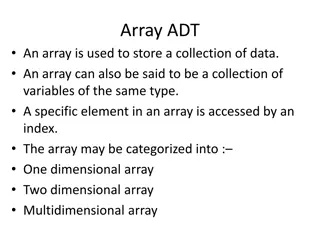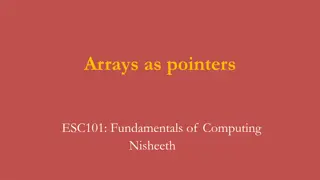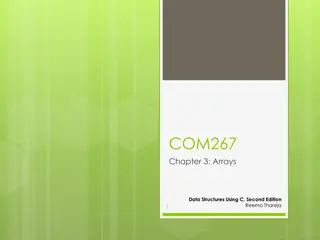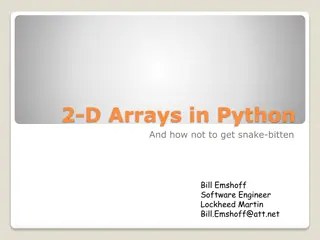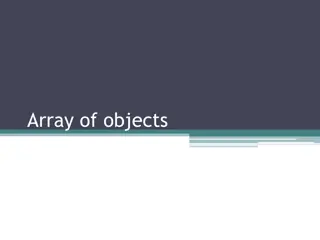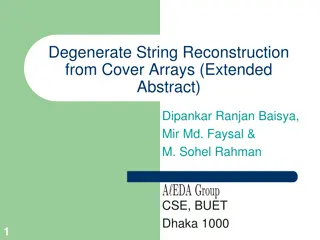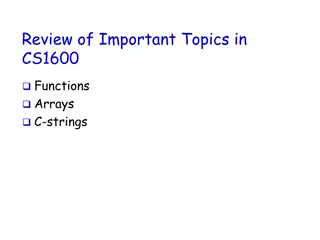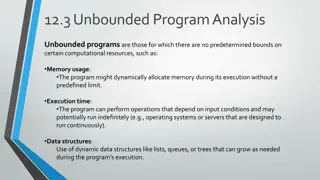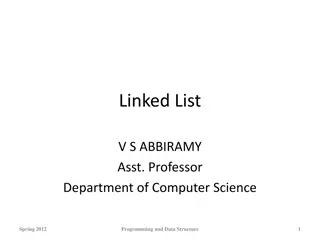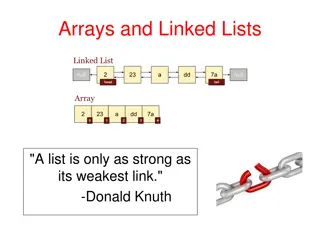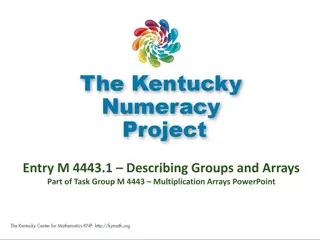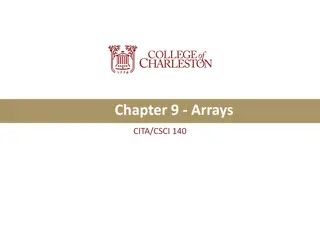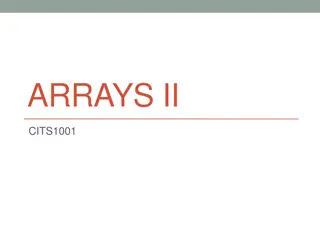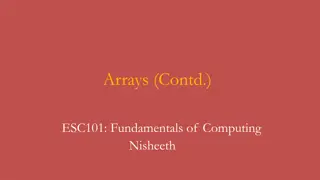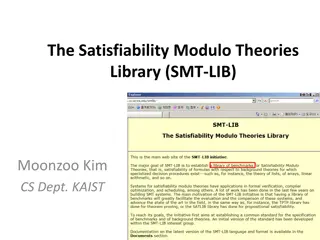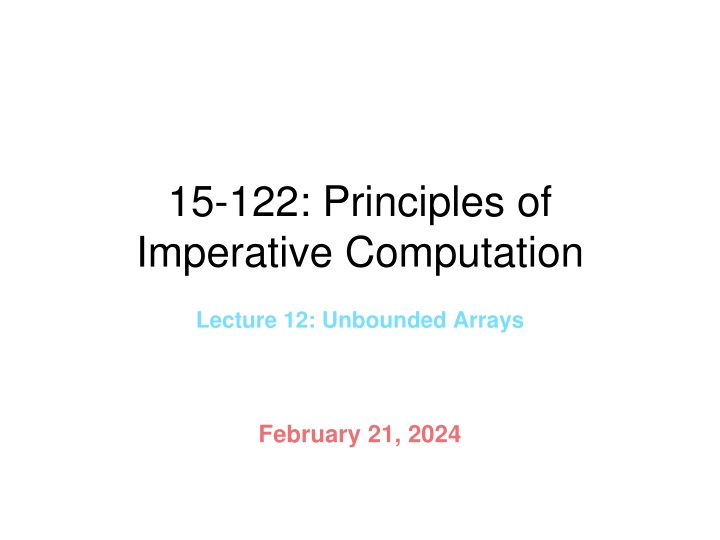
Unbounded Arrays: The Perfect Data Structure for Efficient Access
Learn about unbounded arrays, a versatile data structure combining the advantages of arrays and linked lists for fast access to elements without worrying about size limitations. Explore the Unbounded Array Interface and understand how it facilitates dynamic element addition and removal with constant amortized complexity.
Download Presentation

Please find below an Image/Link to download the presentation.
The content on the website is provided AS IS for your information and personal use only. It may not be sold, licensed, or shared on other websites without obtaining consent from the author. If you encounter any issues during the download, it is possible that the publisher has removed the file from their server.
You are allowed to download the files provided on this website for personal or commercial use, subject to the condition that they are used lawfully. All files are the property of their respective owners.
The content on the website is provided AS IS for your information and personal use only. It may not be sold, licensed, or shared on other websites without obtaining consent from the author.
E N D
Presentation Transcript
15-122: Principles of Imperative Computation Lecture 12: Unbounded Arrays February 21, 2024
Today Last Lecture: Amortized Analysis Today s Lecture: Unbounded arrays Announcements: Programming assignment 5 is due on Feb 23 by 9:00PM There will be a makeup lecture on Sunday, March 03 (same classroom, same time) 1
Lorem ipsum dolor sit amet, consectetur adipiscing elit, sed do eiusmod tempor incididunt ut labore et dolore magna aliqua. Ut enim ad minim veniam, quis nostrud exercitation ullamco laboris nisi ut aliquip ex ea commodo consequat. Duis aute irure Another Problem We want to store all the words in a text file into an array-like data structure so that we can access them fast o We don t know how many words there are ahead of time Use an array? o Access is O(1) o But we don t know how big to make it! Too small and we run out of space Too big and we waste lots of space Use a linked list? o We can make it the exact right size! o But access is O(n) Where n is the number of words in the file 2
Lorem ipsum dolor sit amet, consectetur adipiscing elit, sed do eiusmod tempor incididunt ut labore et dolore magna aliqua. Ut enim ad minim veniam, quis nostrud exercitation ullamco laboris nisi ut aliquip ex ea commodo consequat. Duis aute irure Another Problem We want to store all the words in a text file into an array-like data structure so that we can access them fast o We don t know how many words there are ahead of time What we want is an unbounded array o A data structure that combines the best properties of arrays and linked lists o Access is about O(1) o And size is about right That s what amortized cost is all about! Never too small, and not extravagantly big Same operations as regular arrays, plus o A way to add a new element at the end o A way to remove the last element 3
The Unbounded Array Interface Unbounded Array Interface // typedef ______* uba_t; int uba_len(uba_t A) // O(1) /*@requires A != NULL; /*@ensures \result >= 0; @*/ @*/ ; uba_t uba_new(int size) /*@requires 0 <= size ; /*@ensures \result != NULL; /*@ensures uba_len(\result) == size; @*/ ; @*/ @*/ This is exactly the self-sorting array interface with ssa renamed to uba string uba_get(uba_t A, int i) // O(1) /*@requires A != NULL; /*@requires 0 <= i && i < uba_len(A); @*/ ; @*/ string uba_set(uba_t A, int i, string x) // O(1) /*@requires A != NULL; /*@requires 0 <= i && i < uba_len(A); @*/ ; Doesn t keep elements sorted this time @*/ Add x as the last element of A A grows by 1 element void uba_add(uba_t A, string x) // O(1) amt /*@requires A != NULL; Constant amortized complexity (worst-case could be much higher) @*/ ; string uba_rem(uba_t A) // O(1) amt /*@requires A != NULL; /*@requires 0 < uba_len(A); Remove and return the last element of A A shrinks by 1 element @*/ @*/ ; 4
Towards an Implementation Recall the SSA concrete type // Implementation-side type struct ssa_header { int length; // 0 <= length string[] data; // \length(data) == length }; These are These are // Concrete type representation invariants representation invariants Client view Implementation view A 2 length A "a" "b" "a" "b" data Can we reuse it for unbounded arrays? o Let s add c to it 5
A "a" "b" "c" Towards an Implementation Let s add c to it uba_add(A, "c") A A 2 3 length length "a" "b" "a" "b" data data "a" "b" "c" Create a new 3-element array, copy a and b over, and write c o Copying the old elements to the new array is expensive O(n) for an n-element array Next, let s remove the last element 6
A "a" "b" Towards an Implementation Next, let s remove the last element A A 3 2 length length uba_rem(A) "a" "b" "c" "a" "b" data data "a" "b" "c" "a" "b" Create a new 2-element array, copy a and b over, and return c o Copying the remaining elements to the new array is expensive Again, O(n) 7
A "a" "b" Towards an Implementation Can we do better? o Maybe leave the array alone and just change the length! No need to create a new array! A A 3 2 length length uba_rem(A) "a" "b" "a" "b" data data "a" "b" "c" The last position is unused: We can recycle it o We did not do any copying, just updated the length O(1) for an n-element array Sneaky! Let s continue by adding d 8
A "a" "b" "d" Towards an Implementation Let s continue by adding d uba_add(A, "d") A A 3 2 length length "a" "b" d" "a" "b" data data o All we did is one write! O(1) No need to create a new array: Just use the unused position! But is it safe? o We have no way to know the true length of the array! It used to be that A->length == \length(A->data) When executing A->data[2] = d we don t know if we are going out of bounds Now, all we know is that A->length <= \length(A->data) STOP 9
Towards an Implementation Fix this by splitting length into two fields o size is the size of the unbounded array exported to the user o limit is the true length of the underlying array It will be convenient to have size < limit rather than size <= limit // Implementation-side type struct uba_header { int size; // 0 <= size && size < limit int limit; // 0 < limit string[] data; // \length(data) == limit }; // Concrete type These are representation invariants Implementation view Client view A 2 size A "a" "b" 4 limit "a" "b" data 10
A "a" "b" "c" Towards an Implementation Let s do it all over again o We first add c Write c in the first unused space uba_add(A, "c") A A 2 3 size size 4 4 limit limit "a" "b" "a" "b" "c" data data o No need to copy old array elements Write new element in the first unused space Update size o O(1) for an n-element array Very cheap this time Next, let s remove the last element 11
A "a" "b" Towards an Implementation Next, let s remove the last element A A 3 2 size size uba_rem(A) 4 4 limit limit "a" "b" "c" "a" "b" data data c is still here, but we don t care o Simply decrement size and return element o O(1) Let s continue by adding d 12
A "a" "b" "d" Towards an Implementation Let s continue by adding d Write d where c used to be A A uba_add(A, "d") 2 3 size size 4 4 limit limit "a" "b" "a" "b" "d" data data o As before, just update size o O(1) Let s continue by adding e 13
A "a" "b" "d" "e" Towards an Implementation Let s continue by adding e We can t do that! This violates the invariant: size < limit uba_add(A, "e") A A 4 3 size size 4 4 limit limit "a" "b" "d" "e" "a" "b" "d" data data We need to resizethe array to accommodate e o While satisfying the representation invariants How big should the new array be? 14
A "a" "b" "d" "e" Resizing the Array How big should the new array be? o Onelonger: Just enough to accommodate e uba_add(A, "e") A We need to copy the elements of the old array into the new array 4 size 5 limit "a" "b" "d" data "a" "b" "d" "e" o O(n) for an n-element array The next uba_add will also be O(n) o And the next after that, and the one after, etc., 15
A "a" "b" "d" "e" Resizing the Array How big should the new array be? o Onelonger: Just enough to accommodate e o O(n) for an n-element array, but the next add will also be O(n) A sequence of n uba_add starting from a (limit-1) array costs 1 + 2 + 3 + + (n-1) + n = n(n+1)/2 o That s O(n2) o The amortized cost of each operation is O(n), like the worst-case Can we do better? o Observation: If there is space in the array, uba_add costs just O(1) o Idea: Make the new array bigger than necessary 16
A "a" "b" "d" "e" Resizing the Array How big should the new array be? o Twolonger: Enough to accommodate e and a next element uba_add(A, "e") A 4 size was 4 before 6 limit "a" "b" "d" data "a" "b" "d" "e" o O(n) for an n-element array The next add will be O(1) but the one after will be O(n) again o The cost of a sequence of n uba_add is still O(n2) o The amortized cost stays at O(n) Same if we grow the array by anyfixed amount c 1 + 1 + 3 + 1 + 5 + 1 + + (2n+1) + 1 = 2 + 4 + 6 + + (2n+2) = 2(1 + 2 + 3 + (n+1)) = (n+1)(n+2) 17
A "a" "b" "d" "e" Resizing the Array How big should the new array be? o Double the length! uba_add(A, "e") A 4 size was 4 before 8 limit "a" "b" "d" data "a" "b" "d" "e" o O(n) for an n-element array The next n uba_add will be O(1) o We get good amortized cost when The expensive operations are further and further apart Most operations are cheap o Does doubling the size of the array give us O(1) amortized cost? 18
Amortized Cost of uba_add Conjecture: Doubling the size of the array on resize yields O(1) amortized complexity Let s follow our methodology Invent a notion of token o Represents a unit of cost Determine how many tokens to charge o The candidate amortized cost Specify the token invariant o For any instance of the data structure, how many tokens need to be saved Prove that the operation preserves it o If the invariant holds before, it also holds after Saved tokens before + amortized cost actual cost = saved tokens after 1. Draw a short sequence of operations 2. Write the cost of each operation 3. Flag the most expensive 4. For each operation, compute the total cost up to it 5. Divide the total cost of the most expensive operations by the operation number in the sequence 6. Round up that s the candidate amortized cost 20
Amortized Cost of uba_add Invent a notion of token o Represents a unit of cost For us, the unit of cost will be an array write o 1 array write costs 1 token o All other instructions are cost-free We could also assign a cost to them But let s keep things simple 21
Amortized Cost of uba_add Determine how many tokens to charge o That s the candidate amortized cost 1. Draw a short sequence of operations 2. Write the cost of each operation 3. Flag the most expensive 4. For each operation, compute the total cost up to it 5. Divide the total cost of the most expensive operations by the operation number in the sequence 6. Round up that s the candidate amortized cost When adding an element o We first write it in the old array, and then o If full, copy everything to the new array A uba_add(A, "e") 4 size 8 limit "a" "b" "d" "e" data "a" "b" "d" "e" o This costs 5 tokens Write e in the old array Copy a , b , d , e to the new array a bit silly, but it makes the math simpler 22
Amortized Cost of uba_add 1 size limit data 1 2 a 1. Draw a short sequence of operations 2. Write the cost of each operation 3. Flag the most expensive 4. For each operation, compute the total cost up to it 5. Divide the total cost of the most expensive operations by the operation number in the sequence 6. Round up that s the candidate amortized cost 3 3 3 1 size limit data 2 4 a b 4 1 2 a b size limit data 3 4 a b c 3 9 5 3 size limit data 4 8 a b c d 10 1 4 a b c d size limit data 5 8 a b c d e 11 1 5 size limit data 6 8 a b c d e f 12 1 6 size limit data 7 8 g a b c d e f 3 21 9 7 size limit data 8 16 g a b c d e f h 22 1 8 g a b c d e f h size limit data 9 16 g a b c d e f h I 23
Unit of cost: 1 array write Amortized Cost of uba_add 2 1 size limit data 1 2 a 1. Draw a short sequence of operations 2. Write the cost of each operation 3. Flag the most expensive 4. For each operation, compute the total cost up to it 5. Divide the total cost of the most expensive operations by the operation number in the sequence 6. Round up that s the candidate amortized cost 3 3 3 1 size limit data 2 4 a b 4 1 2 a b size limit data 3 4 a b c 3 9 5 3 size limit data 4 8 a b c d 10 1 4 a b c d size limit data 5 8 a b c d e 11 1 5 size limit data 6 8 a b c d e f 12 1 6 size limit data 7 8 g a b c d e f 3 21 9 7 size limit data 8 16 g a b c d e f h 22 1 8 g a b c d e f h size limit data 9 16 g a b c d e f h I 24
Unit of cost: 1 array write Amortized Cost of uba_add 2 1 size limit data 1 2 a 1. Draw a short sequence of operations 2. Write the cost of each operation 3. Flag the most expensive 4. For each operation, compute the total cost up to it 5. Divide the total cost of the most expensive operations by the operation number in the sequence 6. Round up that s the candidate amortized cost 3 3 3 1 size limit data 2 4 a b 4 1 2 a b size limit data 3 4 a b c 3 9 5 3 size limit data 4 8 a b c d 10 1 4 a b c d size limit data 5 8 a b c d e 11 1 5 size limit data 6 8 a b c d e f 12 1 6 size limit data 7 8 g a b c d e f 3 21 9 7 size limit data 8 16 g a b c d e f h 22 1 8 g a b c d e f h size limit data 9 16 g a b c d e f h I 25
Unit of cost: 1 array write Amortized Cost of uba_add 2 1 size limit data 1 2 a 1. Draw a short sequence of operations 2. Write the cost of each operation 3. Flag the most expensive 4. For each operation, compute the total cost up to it 5. Divide the total cost of the most expensive operations by the operation number in the sequence 6. Round up that s the candidate amortized cost 3 3 3 1 size limit data 2 4 a b 4 1 2 a b size limit data 3 4 a b c 3 9 5 3 size limit data 4 8 a b c d 10 1 4 a b c d size limit data 5 8 a b c d e 11 1 5 size limit data 6 8 a b c d e f 12 1 6 size limit data 7 8 g a b c d e f 3 21 9 7 size limit data 8 16 g a b c d e f h 22 1 8 g a b c d e f h size limit data 9 16 g a b c d e f h I 26
Unit of cost: 1 array write Amortized Cost of uba_add 2 1 size limit data 1 2 a 1. Draw a short sequence of operations 2. Write the cost of each operation 3. Flag the most expensive 4. For each operation, compute the total cost up to it 5. Divide the total cost of the most expensive operations by the operation number in the sequence 6. Round up that s the candidate amortized cost 3 3 3 1 size limit data 2 4 a b 4 1 2 a b size limit data 3 4 a b c 3 9 5 3 size limit data 4 8 a b c d 10 1 4 a b c d size limit data 5 8 a b c d e 11 1 5 size limit data 6 8 a b c d e f 12 1 6 size limit data 7 8 g a b c d e f 3 21 9 7 size limit data 8 16 g a b c d e f h 22 1 8 g a b c d e f h size limit data 9 16 g a b c d e f h I 27
Unit of cost: 1 array write Amortized Cost of uba_add 2 1 size limit data 1 2 a 1. Draw a short sequence of operations 2. Write the cost of each operation 3. Flag the most expensive 4. For each operation, compute the total cost up to it 5. Divide the total cost of the most expensive operations by the operation number in the sequence 6. Round up that s the candidate amortized cost 3 3 3 1 size limit data 2 4 a b 4 1 2 a b size limit data 3 4 a b c 3 9 5 3 size limit data 4 8 a b c d 10 1 4 a b c d size limit data 5 8 a b c d e 11 1 5 size limit data 6 8 a b c d e f 12 1 6 size limit data 7 8 g a b c d e f 3 21 9 7 size limit data 8 16 g a b c d e f h 22 1 8 g a b c d e f h size limit data 9 16 g a b c d e f h I 28
Unit of cost: 1 array write Amortized Cost of uba_add 2 1 size limit data 1 2 a 1. Draw a short sequence of operations 2. Write the cost of each operation 3. Flag the most expensive 4. For each operation, compute the total cost up to it 5. Divide the total cost of the most expensive operations by the operation number in the sequence 6. Round up that s the candidate amortized cost 3 3 3 1 size limit data 2 4 a b 4 1 2 a b size limit data 3 4 a b c 3 9 5 3 size limit data 4 8 a b c d 10 1 4 a b c d size limit data 5 8 a b c d e 11 1 5 size limit data 6 8 a b c d e f 12 1 6 size limit data 7 8 g a b c d e f 3 21 9 7 size limit data 8 16 g a b c d e f h 22 1 8 g a b c d e f h size limit data 9 16 g a b c d e f h I 29
Unit of cost: 1 array write Amortized Cost of uba_add 2 1 size limit data 1 2 a 1. Draw a short sequence of operations 2. Write the cost of each operation 3. Flag the most expensive 4. For each operation, compute the total cost up to it 5. Divide the total cost of the most expensive operations by the operation number in the sequence 6. Round up that s the candidate amortized cost 3 3 3 1 size limit data 2 4 a b 4 1 2 a b size limit data 3 4 a b c 3 9 5 3 size limit data 4 8 a b c d 10 1 4 a b c d size limit data 5 8 a b c d e 11 1 5 size limit data 6 8 a b c d e f 12 1 6 size limit data 7 8 g a b c d e f 3 21 9 7 size limit data 8 16 g a b c d e f h 22 1 8 g a b c d e f h size limit data 9 16 g a b c d e f h I 30
Unit of cost: 1 array write Amortized Cost of uba_add 2 1 size limit data 1 2 a 1. Draw a short sequence of operations 2. Write the cost of each operation 3. Flag the most expensive 4. For each operation, compute the total cost up to it 5. Divide the total cost of the most expensive operations by the operation number in the sequence 6. Round up that s the candidate amortized cost 3 3 3 1 size limit data 2 4 a b 4 1 2 a b size limit data 3 4 a b c 3 9 5 3 size limit data 4 8 a b c d 10 1 4 a b c d size limit data 5 8 a b c d e 11 1 5 size limit data 6 8 a b c d e f 12 1 6 size limit data 7 8 g a b c d e f 3 21 9 7 size limit data 8 16 g a b c d e f h 22 1 8 g a b c d e f h size limit data 9 16 g a b c d e f h I 31
Unit of cost: 1 array write Amortized Cost of uba_add 2 1 size limit data 1 2 a 1. Draw a short sequence of operations 2. Write the cost of each operation 3. Flag the most expensive 4. For each operation, compute the total cost up to it 5. Divide the total cost of the most expensive operations by the operation number in the sequence 6. Round up that s the candidate amortized cost 3 3 3 1 size limit data 2 4 a b 4 1 2 a b size limit data 3 4 a b c 3 9 5 3 size limit data 4 8 a b c d 10 1 4 a b c d size limit data 5 8 a b c d e 11 1 5 size limit data 6 8 a b c d e f 12 1 6 size limit data 7 8 g a b c d e f 3 21 9 7 size limit data 8 16 g a b c d e f h 22 1 8 g a b c d e f h size limit data 9 16 g a b c d e f h I 32
Unit of cost: 1 array write Amortized Cost of uba_add 2 1 size limit data 1 2 a 1. Draw a short sequence of operations 2. Write the cost of each operation 3. Flag the most expensive 4. For each operation, compute the total cost up to it 5. Divide the total cost of the most expensive operations by the operation number in the sequence 6. Round up that s the candidate amortized cost 3 3 3 3 1 size limit data 2 4 a b 4 1 2 a b size limit data 3 4 a b c 3 3 9 5 3 size limit data 4 8 a b c d 10 1 4 a b c d size limit data 5 8 a b c d e 11 1 5 size limit data 6 8 a b c d e f 12 1 6 size limit data 7 8 g a b c d e f 3 3 21 9 7 size limit data 8 16 g a b c d e f h 22 1 8 g a b c d e f h size limit data 9 16 g a b c d e f h I 33
Unit of cost: 1 array write 4 Amortized Cost of uba_add 2 1 size limit data 1 2 a 1. Draw a short sequence of operations 2. Write the cost of each operation 3. Flag the most expensive 4. For each operation, compute the total cost up to it 5. Divide the total cost of the most expensive operations by the operation number in the sequence 6. Round up that s the candidate amortized cost 3 3 3 3 1 size limit data 2 4 a b 4 1 2 a b size limit data 3 4 a b c 3 3 9 5 3 size limit data 4 8 a b c d 10 1 4 a b c d size limit data 5 8 a b c d e 11 1 5 size limit data 6 8 a b c d e f 12 1 6 size limit data 7 8 g a b c d e f 3 3 21 9 7 size limit data 8 16 g a b c d e f h 22 1 8 g a b c d e f h size limit data 9 16 g a b c d e f h I 34
Unit of cost: 1 array write 4 Amortized Cost of uba_add 2 1 size limit data 1 2 a 1. Draw a short sequence of operations 2. Write the cost of each operation 3. Flag the most expensive 4. For each operation, compute the total cost up to it 5. Divide the total cost of the most expensive operations by the operation number in the sequence 6. Round up that s the candidate amortized cost 3 3 3 3 1 size limit data 2 4 a b 4 1 2 a b size limit data 3 4 a b c 3 3 9 5 3 size limit data 4 8 a b c d 10 1 4 a b c d size limit data 5 8 a b c d e 11 1 5 size limit data 6 8 a b c d e f 12 1 6 size limit data 7 8 g a b c d e f 3 3 21 9 7 size limit data 8 16 g a b c d e f h 22 1 8 g a b c d e f h size limit data 9 16 g a b c d e f h I 35
Unit of cost: 1 array write 4 Amortized Cost of uba_add 2 1 size limit data 1 2 a 1. Draw a short sequence of operations 2. Write the cost of each operation 3. Flag the most expensive 4. For each operation, compute the total cost up to it 5. Divide the total cost of the most expensive operations by the operation number in the sequence 6. Round up that s the candidate amortized cost 3 3 3 3 1 size limit data 2 4 a b 4 1 2 a b size limit data 3 4 a b c 3 3 9 5 3 size limit data 4 8 a b c d 10 1 4 a b c d size limit data 5 8 a b c d e 11 1 5 size limit data 6 8 a b c d e f 12 1 6 size limit data 7 8 g a b c d e f 3 3 21 9 7 size limit data 8 16 g a b c d e f h 22 1 8 g a b c d e f h size limit data 9 16 g a b c d e f h I 36
Unit of cost: 1 array write 4 Amortized Cost of uba_add 2 1 size limit data 1 2 a 1. Draw a short sequence of operations 2. Write the cost of each operation 3. Flag the most expensive 4. For each operation, compute the total cost up to it 5. Divide the total cost of the most expensive operations by the operation number in the sequence 6. Round up that s the candidate amortized cost 3 3 3 3 1 size limit data 2 4 a b 4 1 2 a b size limit data 3 4 a b c 3 3 9 5 3 size limit data 4 8 a b c d 10 1 4 a b c d size limit data 5 8 a b c d e 11 1 5 size limit data 6 8 a b c d e f 12 1 6 size limit data 7 8 g a b c d e f 3 3 21 9 7 size limit data 8 16 g a b c d e f h 22 1 8 g a b c d e f h size limit data 9 16 g a b c d e f h I 37
Unit of cost: 1 array write 4 Amortized Cost of uba_add 2 1 size limit data 1 2 a 1. Draw a short sequence of operations 2. Write the cost of each operation 3. Flag the most expensive 4. For each operation, compute the total cost up to it 5. Divide the total cost of the most expensive operations by the operation number in the sequence 6. Round up that s the candidate amortized cost 3 3 3 3 1 size limit data 2 4 a b 4 1 2 a b size limit data 3 4 a b c 3 3 9 5 3 size limit data 4 8 a b c d 10 1 4 a b c d size limit data 5 8 a b c d e 11 1 5 size limit data 6 8 a b c d e f 12 1 6 size limit data 7 8 g a b c d e f 3 3 21 9 7 size limit data 8 16 g a b c d e f h 22 1 8 g a b c d e f h size limit data 9 16 g a b c d e f h I 38
Unit of cost: 1 array write 4 Amortized Cost of uba_add 2 1 size limit data 1 2 a 1. Draw a short sequence of operations 2. Write the cost of each operation 3. Flag the most expensive 4. For each operation, compute the total cost up to it 5. Divide the total cost of the most expensive operations by the operation number in the sequence 6. Round up that s the candidate amortized cost 3 3 3 3 1 size limit data 2 4 a b 4 1 2 a b size limit data 3 4 a b c 3 3 9 5 3 size limit data 4 8 a b c d 10 1 4 a b c d size limit data 5 8 a b c d e 11 1 5 size limit data 6 8 a b c d e f 12 1 6 size limit data 7 8 g a b c d e f 3 3 21 9 7 size limit data 8 16 g a b c d e f h 22 1 8 g a b c d e f h size limit data 9 16 g a b c d e f h I 39
Unit of cost: 1 array write 4 Amortized Cost of uba_add 2 1 size limit data 1 2 a 1. Draw a short sequence of operations 2. Write the cost of each operation 3. Flag the most expensive 4. For each operation, compute the total cost up to it 5. Divide the total cost of the most expensive operations by the operation number in the sequence 6. Round up that s the candidate amortized cost 3 3 3 3 1 size limit data 2 4 a b 4 1 2 a b size limit data 3 4 a b c 3 3 9 5 3 size limit data 4 8 a b c d 10 1 4 a b c d size limit data 5 8 a b c d e 11 1 5 size limit data 6 8 a b c d e f 12 1 6 size limit data 7 8 g a b c d e f 3 3 21 9 7 size limit data 8 16 g a b c d e f h 22 1 8 g a b c d e f h size limit data 9 16 g a b c d e f h I 40
Unit of cost: 1 array write 4 Amortized Cost of uba_add 2 1 size limit data 1 2 a 1. Draw a short sequence of operations 2. Write the cost of each operation 3. Flag the most expensive 4. For each operation, compute the total cost up to it 5. Divide the total cost of the most expensive operations by the operation number in the sequence 6. Round up that s the candidate amortized cost 3 3 3 3 1 size limit data 2 4 a b 4 1 2 a b size limit data 3 4 a b c 3 3 9 5 3 size limit data 4 8 a b c d 10 1 4 a b c d size limit data 5 8 a b c d e 11 1 5 size limit data 6 8 a b c d e f 12 1 6 size limit data 7 8 g a b c d e f 3 3 21 9 7 size limit data 8 16 g a b c d e f h 22 1 8 g a b c d e f h size limit data 9 16 g a b c d e f h I 41
Unit of cost: 1 array write 4 Amortized Cost of uba_add 2 1 5 size limit data 1 2 a 1. Draw a short sequence of operations 2. Write the cost of each operation 3. Flag the most expensive 4. For each operation, compute the total cost up to it 5. Divide the total cost of the most expensive operations by the operation number in the sequence 6. Round up that s the candidate amortized cost 3 3 3 3 1 size limit data 2 4 a b 4 1 2 a b size limit data 3 4 a b c 3 3 9 5 3 size limit data 4 8 a b c d 10 1 4 a b c d size limit data 5 8 a b c d e 11 1 5 size limit data 6 8 a b c d e f 12 1 6 size limit data 7 8 g a b c d e f 3 3 21 9 7 size limit data 8 16 g a b c d e f h 22 1 8 g a b c d e f h size limit data 9 16 g a b c d e f h I 42
Unit of cost: 1 array write 4 Amortized Cost of uba_add 2 1 5 size limit data 1 2 a 1. Draw a short sequence of operations 2. Write the cost of each operation 3. Flag the most expensive 4. For each operation, compute the total cost up to it 5. Divide the total cost of the most expensive operations by the operation number in the sequence 6. Round up that s the candidate amortized cost 3 3 3 3 1 size limit data 2 4 a b 4 1 2 a b size limit data 3 4 a b c 3 3 9 5 3 size limit data 4 8 a b c d 10 1 4 a b c d size limit data 5 8 a b c d e Charge 3 tokens per uba_add 11 1 5 size limit data 6 8 a b c d e f 12 1 6 size limit data 3 6 7 8 g a b c d e f 3 Candidate amortized cost 3 21 9 7 size limit data 8 16 g a b c d e f h 22 1 8 g a b c d e f h size limit data 9 16 g a b c d e f h I 43
Amortized Cost of uba_add Specify the token invariant o For any instance of the data structure, how many tokens need to be saved How are the 3 tokens charged for an uba_add used? o We always write the added element to the old array 1 token used to write the new element o The remaining 2 tokens are saved Where do they go? 44
Amortized Cost of uba_add How are the 3 tokens charged for an uba_add used? o 1 token used to write the new element o Where do the remaining 2 tokens go? Assume: o We have just resized the array and have no tokens left We spent all saved tokens resizing size limit data 2 4 a b add "c" size limit data 3 4 a b c add "d" size limit data We spent 4 tokens copying the elements 4 8 a b c d a b c d In essence each token is associated with an element in the old array 45
Amortized Cost of uba_add How are the 3 tokens charged for an uba_add used? o 1 token used to write the new element o Each of the remaining 2 tokens is associated with an element in the old array 1 token to copy the element we just wrote Always in the 2nd half of the array 1 token to copy the matching element in the first half of the array Element that was copied on the last resize 1st half: Elements inherited from last resize 2nd half: Elements added after last resize 1st half 2nd half size limit data 2 4 a b add "c" size limit data 3 4 a b c add "d" size limit data 4 8 a b c d a b c d 46
Amortized Cost of uba_add The token invariant o Every element in the 2nd half of the array has a token o And the corresponding element in the 1st half of the array has a token 2nd half 1st half size limit data k+r 2k r r k k Alternative formulation: o An array with limit 2k and size k+r holds 2r tokens (for 0 r < k) # tokens == 2r Both assume a resize has happened previously 47
Amortized Cost of uba_add Prove that the operation preserves the token invariant o If the invariant holds before, it also holds after Saved tokens before + amortized cost actual cost = saved tokens after We need to distinguish between two cases 1. Adding an element does not trigger a resize 2. Adding an element does trigger a resize and we will need to see what happens before the first resize 48
Amortized Cost of uba_add Saved tokens before + amortized cost actual cost = saved tokens after 1. Adding an element does not trigger a resize We receive 3 tokens We spend 1 to write the new element We put 1 on top of the new element We put 1 on top of the matching element in the 1st half of the array size limit data k+r 2k r r uba_add k k size limit data k+r+1 2k r = r+1 r = r+1 k = k k = k Alternatively, # tokens after = # tokens before + 3 1 = 2r + 2 = 2(r+1) = 2r 49

